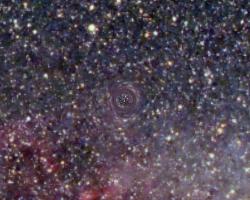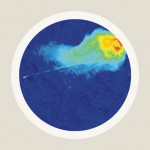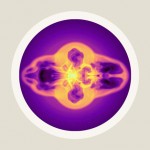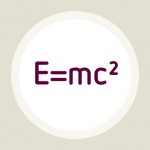Descent into a black hole
The story of an expedition’s closer and closer approach to a black hole – too close?
An article by Ute Kraus
The spaceship Yonjuni with its crew of specialist robots – purpose-built for deep-space exploration – is on its way to the centre of the Milky Way. All kinds of sensors transmit astrophysical data back to Earth, and there is also a visual transmission by three main cameras: camera 1, which is pointed straight ahead, camera 2 pointed to the right of the directon of flight and camera 3 pointed straight back.
A view of the Milky Way
After years of flight – the Earth has long-since become invisible, and the sun a star among stars – the outside view shows the Milky Way as a band of stars, luminous gas and dark dust clouds.

All cameras are in wide-angle mode, each covering 90 degrees, so that, combined, the three cameras together give a panorama reaching from the direction of flight to the left all the way to the back.
Then, a warning message from the central computer: the space-ship has begun unplanned acceleration, just as if it were close to a planet or a star – but the cameras show no such astronomical body close-by!
The mission control module classifies the event as “scientifically of interest”, “justifying a change-of-course”, “presumably harmless”, and adjusts the course of the space-ship for further exploration.
First view of the black hole
Camera 1 is shifted into zoom mode and, in the constellation Cygnus, discovers a small, ring-like, fuzzy structure:

Meanwhile, the scientific software on the main computer has already identified the object: It is a black hole of ten times the mass of a sun, at a distance of a mere 1.2 million kilometres from the space-ship.
A unique opportunity to study a black hole’s gravity at first hand. With 100 g (a hundred times the standard acceleration on Earth), the photon engines keep the distance to the black hole constant, while gyroscopic experiments are set up that will measure the black hole’s angular momentum. At this point, the lightly built service robots experience the first cases of deformation due to gravitational forces, and also the the first cases of material fatigue. The energy needed to keep the space-ship stationary is enourmous, and in order not to jeopardize the mission, the stay cannot be long.
Unfortunately, a cosmic particle traverses the IT compartment of the space-ship, home of the on-board computer system, and the indicator bit “fuel sufficient for the rest of the mission” is permanently set to “true”.
The main computer initiates a closer approach to the black hole.
A closer approach
At an acceleration of 15 million g, the space-ship hovers 3000 km above the black hole; gravitational forces have reduced the robots to scrap metal. By now, the ring structure is clearly visible. Behind that structure is the fact that, close to the black hole, light is deflected. The image of the clouds of gas and dust behind the black hole is distorted and arc-like. In the centre of the structure, the centre-region of the black hole becomes visible: a small disk that is completely black.

Next stop: a distance of mere 600 km from the black hole (400 millionen g are needed to help thespace-ship keep its distance). Multiple images are clearly visible now: within the circle, there is a second image of the whole of the Milky Way.

A distance of 150 kilometres (9 billion g). The black central region now occupies a substantial fraction of the field-of-view.

90 km above the black hole’s horizon (30 billion g) – camera 1 now sees nothing else but that black central region.

Distance 45 km, acceleration 100 billion g: the space-ship has reached what is called the photon radius: The black hole now occupies exactly half of the celestial orb.

Distance 30 km (at 200 billion g): from the point of view of the space-ship, the black hole occupies more than half of the night sky.

The horizon is now a mere 13 km away. An acceleration of 650 billion g is needed to keep the space-ship in position. The only way to see the stars is to look back – in front of the space ship and to all sides, darkness reigns.

For a brief moment, and at an acceleration of 2 trillion g, the space-ship keeps a distance of 4 km to the horizon. Looking back, the starry skies are compressed into a small region of the sky. For every star, multiple images are visible.

Main on-board computer to Tanageshima Space Center: END OF MISSION
Comment 1:
As observerd from a stationary position close to a black hole, stellar radiation is shifted towards shorter wave-lengths and higher intensities: stars look more blueish and brighter than usual. Also, there is a distinct change in the appearance of the Milky Way: what reaches the aforementioned observer as visible light is the infrared radiation emitted by far-away light sources. The clouds of gas and dust become invisible – as far as infrared radiation is concerned, they are perfectly transparent. At the same time, stars become visible that, for an observer on Earth, are obscured by the clouds in question. In the above images, these effects have not been taken into account.
Comment 2:
In the story, there is talk of gigantic accelerations. The engine that could bring about those accalerations is just as fictional as the space-ship that could survive them. However, the same optical effects could be observed at much lower accelerations if the mass of the black hole is substantially larger. For instance, a mere 1 g is needed to hover at 1.005 times the Schwarzschild radius (corresponding to the last picture) if the black hole has 20 trillion times the solar mass.
Further Information
For basic information about black holes, check out Elementary Einstein, in particular the chapter Black holes & Co..
Related Spotlights on relativity on Einstein-Online can be found in the section Black holes & Co..
More simulations by Ute Kraus and colleagues can be found on the Space Time Travel Pages
Credit
The pictures above make use of Axel Mellinger’s All-Sky Milky-Way Panorama (at low resolution), cf. http://home.arcor-online.de/axel.mellinger/allsky.html
Colophon
is a professor of physic at Hildesheim University.
Citation
Cite this article as:
Ute Kraus, “Descent into a black hole” in: Einstein Online Band 01 (2005), 01-1019









